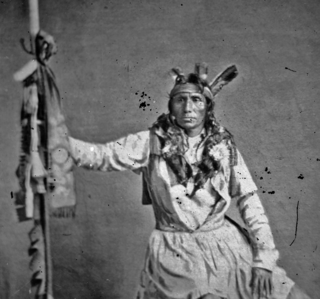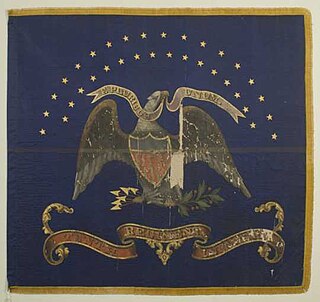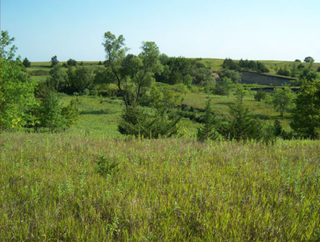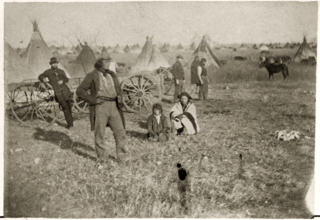
Meeker County is a county in the U.S. state of Minnesota. As of the 2020 census, the population was 23,400. Its county seat is Litchfield.

The Battle of Fort Ridgely was an early battle in the Dakota War of 1862. As the closest U.S. military post to the Lower Sioux Agency, the lightly fortified Fort Ridgely quickly became both a destination for refugees and a target of Dakota warbands after the attack at the Lower Sioux Agency. It came under attack by the Dakota on August 20, 1862, two days after a company of soldiers responding from the fort to the attack on the Lower Sioux Agency had been ambushed and defeated at the Battle of Redwood Ferry. The Dakota besieged and partially destroyed the fort, but were unable to storm it before the August 27 arrival of Colonel Henry Sibley with 1400 men from Fort Snelling prompted them to retreat.

Fort Ridgely was a frontier United States Army outpost from 1851 to 1867, built 1853–1854 in Minnesota Territory. The Sioux called it Esa Tonka. It was located overlooking the Minnesota river southwest of Fairfax, Minnesota. Half of the fort's land was part of the south reservation in the Minnesota river valley for the Mdewakanton and Wahpekute tribes. Fort Ridgely had no defensive wall, palisade, or guard towers. The Army referred to the fort as the "New Post on the Upper Minnesota" until it was named for three Maryland Army Officers named Ridgely, who died during the Mexican–American War.

Little Crow III was a Mdewakanton Dakota chief who led a faction of the Dakota in a five-week war against the United States in 1862.

The Lower Sioux Agency, or Redwood Agency, was the federal administrative center for the Lower Sioux Indian Reservation in what became Redwood County, Minnesota, United States. It was the site of the Battle of Lower Sioux Agency on August 18, 1862, the first organized battle of the Dakota War of 1862.

The Battle of Redwood Ferry took place on August 18, 1862, on the first day of the Dakota War of 1862. A United States Army company responding to the Dakota attack at the Lower Sioux Agency from Fort Ridgeley was ambushed and defeated at Redwood Ferry.

Big Eagle was the chief of a band of Mdewakanton Dakota in Minnesota. He played an important role as a military leader in the Dakota War of 1862. Big Eagle surrendered soon after the Battle of Wood Lake and was sentenced to death and imprisoned, but was pardoned by President Abraham Lincoln in 1864. Big Eagle's narrative, "A Sioux Story of the War" was first published in 1894, and is one of the most widely cited first-person accounts of the 1862 war in Minnesota from a Dakota point of view.

The Forest City Stockade was built in central Minnesota to defend settlers in the area from Indian attacks. It became famous during the Dakota War of 1862, when it was besieged by the Dakota as part of Little Crow's attack on Forest City. In the 21st century, the rebuilt stockade functions as a tourist attraction and memorial to the battle. Visitors to the site can visit a rebuilt stockade and see volunteers in 19th-century dress illustrate period life and activities. A threshing bee takes place across the road in August. The site of the stockade is between Litchfield and Forest City near Minnesota State Highway 24.

The 10th Minnesota Infantry Regiment was a Minnesota USV infantry regiment that served in the Union Army during the American Civil War.

The Battle of Wood Lake occurred on September 23, 1862, and was the final battle in the Dakota War of 1862. The two-hour battle, which actually took place at nearby Lone Tree Lake, was a decisive victory for the U.S. forces led by Colonel Henry Hastings Sibley. With heavy casualties inflicted on the Dakota forces led by Chief Little Crow, the "hostile" Dakota warriors dispersed. Little Crow and 150 followers fled for the northern plains, while other Mdewakantons quietly joined the "friendly" Dakota camp started by the Sisseton and Wahpeton bands, which would soon become known as Camp Release.

The Battle of Birch Coulee occurred September 2–3, 1862 and resulted in the heaviest casualties suffered by U.S. forces during the Dakota War of 1862. The battle occurred after a group of Dakota warriors followed a U.S. burial expedition, including volunteer infantry, mounted guards and civilians, to an exposed plain where they were setting up camp. That night, 200 Dakota soldiers surrounded the camp and ambushed the Birch Coulee campsite in the early morning, commencing a siege that lasted for over 30 hours, until the arrival of reinforcements and artillery led by Colonel Henry Hastings Sibley.

The Attack at the Lower Sioux Agency was the first organized attack led by Dakota leader Little Crow in Minnesota on August 18, 1862, and is considered the initial engagement of the Dakota War of 1862. It resulted in 13 settler deaths, with seven more killed while fleeing the agency for Fort Ridgely.

The Battles of New Ulm, also known as the New Ulm Massacre, were two battles in August 1862 between Dakota men and European settlers and militia in New Ulm, Minnesota early in the Dakota War of 1862. Dakota forces attacked New Ulm on August 19 and again on August 23, destroying much of the town but failing to fully capture it. After the second attack, New Ulm was evacuated.

The Surrender at Camp Release was the final act in the Dakota War of 1862. After the Battle of Wood Lake, Colonel Henry Hastings Sibley had considered pursuing the retreating Sioux, but he realized he did not have the resources for a vigorous pursuit. Furthermore, he was aware that Chief Little Crow had been losing support and was in contact with several Mdewakanton chiefs who had signaled their opposition to further conflict.

The US–Dakota War of 1862, also known as the Sioux Uprising, the Dakota Uprising, the Sioux Outbreak of 1862, the Dakota Conflict, or Little Crow's War, was an armed conflict between the United States and several eastern bands of Dakota collectively known as the Santee Sioux. It began on August 18, 1862, when the Dakota, who were facing starvation and displacement, attacked white settlements at the Lower Sioux Agency along the Minnesota River valley in southwest Minnesota. The war lasted for five weeks and resulted in the deaths of hundreds of settlers. In the aftermath, the Dakota people were exiled from their homelands, forcibly sent to reservations in the Dakotas and Nebraska, and the State of Minnesota confiscated and sold all their remaining land in the state. The war also ended with the largest mass hanging in United States history with hanging of 38 Dakota men.
The 1st Dakota Cavalry was a Union battalion of two companies raised in the Dakota Territory during the American Civil War. They were deployed along the frontier, primarily to protect the settlers during the Sioux Uprising of 1862.
The Department of the Northwest was an U.S. Army Department created September 6, 1862 to put down the Sioux uprising in Minnesota. Major General John Pope was made commander of the Department. At the end of the Civil War the Department was redesignated the Department of Dakota. Immediately upon arriving in St. Paul General Pope sent letters to the Governors of Iowa and Wisconsin for additional troops to assist the 5th Minnesota Infantry Regiment. From Iowa he got the 27th Iowa Infantry Regiment and from Wisconsin he received the 25th Wisconsin Infantry Regiment. Both quickly crossed the border to assist with the uprising. The 25th Wisconsin was in Minnesota three months and the 27th Iowa was there a month before both headed south. After they departed, the Minnesota District would be garrisoned by Minnesota units: 5th, 6th, 7th, 8th, 9th, 10th Infantry Regiments, 1st and 2nd Minnesota Cavalry Regiments plus Minnesota Independent Cavalry Battalion as well as the 3rd Minnesota Light Artillery Battery. In 1864 companies of the 30th Wisconsin Infantry Regiment would see service in the Minnesota and Dakota Districts too.
Acton is an unincorporated community in Acton Township, Meeker County, Minnesota, United States, near Grove City and Litchfield. The community is located along Meeker County Road 23 near State Highway 4. County Road 32 is also in the immediate area.

The Battle of Acton was a battle between the United States Army and Little Crow's band of Dakota warriors during the Dakota War of 1862. Following the defeats at Fort Ridgley and New Ulm, Chief Little Crow led an incursion north out of the Minnesota River Valley into central Minnesota. A detachment of the Tenth Minnesota Infantry Regiment commanded by Captain Richard Strout was sent to protect the citizens of Meeker County.

The Attack on Hutchinson occurred on September 4, 1862 during the Dakota War of 1862 as a part of Chief Little Crow's incursion into the Big Woods area of Minnesota. On September 3, Little Crow encountered Captain Strout's detachment of the 10th Minnesota Infantry Regiment near Acton and chased it to the stockade of the town of Hutchinson. On September 4 Little Crow attacked with 200 warriors and destroyed most of the buildings outside of the stockade. Small firefights broke out between the Hutchinson Home Guard and Sioux warriors, but the Dakota failed to breach the town's defenses. Little Crow's men subsequently retreated, bringing as much loot as they could carry.



















